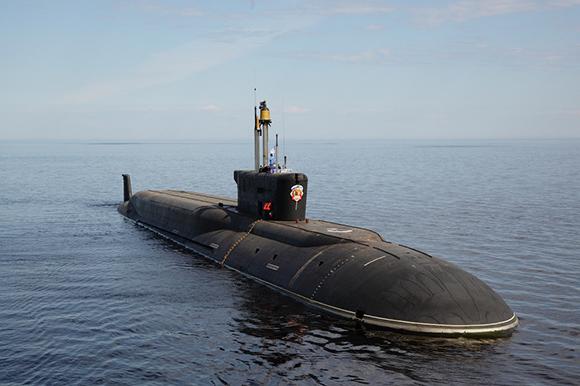In 2016, the “Borei” and “Yasen” production line will continue at full capacity. This is what the yard communicates Sevmash, in the north west of Russia.
The entire “Borei” class (photo) cannot yet enter service because it does not have the equipment to carry it out. Each 'Borei' is expected to carry sixteen to twenty "Bulava" missiles (955U only), each equipped with six to ten Mirv warheads. There are eight 'Borei' class submarines that will equip the Russian navy by 2020.
The Russians are optimistic about the “Bulava” missiles and the “Borei” class submarines, which are responsible for nuclear deterrence until at least 2050. The test launches will be completed within the year. The missiles will be launched from submarines in the Northern and Pacific Fleet. The three-stage missile "Bulava", codenamed NATO SS-N-30 Mace, is the naval version of the most advanced Russian ballistic missile, the SS-27 Topol-M. It can also be launched on the go. It carries up to 10 Mirv warheads, can hit targets up to eight thousand kilometers away and is designed to equip exclusively “Borei” class nuclear submarines.
Despite numerous failures due to manufacturing defects, the Russian military argues that there is no alternative to "Bulava". Due to the failure of the new "Bulava" intercontinental missiles to test, the "Borei" are still unable to perform their primary task, namely nuclear deterrence.
The first "Borei", the "Yury Dolgoruky" K535, joined the Northern Fleet in January 2013, followed by the K-550 (Project 955A) "Aleksandr Nevskij" at the end of December of the same year. The "Vladimir Monomakh" entered service in 2014, while the fourth "Borei", the "Knyaz Vladimir" has been under construction since July 2012 at the Sevmash shipyard in northern Russia. Construction of the fifth nuclear-powered submarine "Knyaz Oleg" began last July. The construction sites for the sixth “Borei”, the “Generalissimus Suvorov” and the seventh, “Imperator Aleksandr III”, are being prepared. Borei-class submarines will form the backbone of the Navy's strategic nuclear deterrent. They will replace the class submarines Typhoon, Delta-3 and Delta-4.
Each “Bulava” missile is armed with 6-10 thermonuclear warheads for 96-196 submarine warheads. The possible coverage of sensitive targets, considering the range of eight thousand kilometers, could be the Barents Sea and the Sea of Okhotsk. If the Russians launched from these areas, they could hit anywhere in the continental United States. The Russian Navy will receive the second "Yasen" class submarine by 2016 and will present substantial improvements over the leader "Severodvinsk" 885 project.
The first submarine 885m project, the "Kazan", is expected to be delivered to the Russian Navy in 2016. The "K-329 Severodvinsk", the first Russian attack submarine project 885 class "Yasen", completed its final tests in December last year and was delivered to the Navy with many doubts. A government commission set up for the occasion then gave the green light for the commissioning with some improvements that would be adopted in the following "Yasen". According to some unconfirmed sources, in fact, the Navy General Staff was not fully convinced of the "Severodvinsk" due to unspecified technical problems. The K-329 subsequently successfully completed four rounds of sea trials.
The "Yasen" class multirole nuclear attack submarine has an underwater displacement of 13.800 tons. It is long of 119 meters, with a maximum speed of thirty one knots in immersion. It can dive up to 600 meters, even if the operating depth is on the 500 meters. It has a crew of ninety men, including thirty-two officers. The "Yasen" class submarines are considered (by the Russians) as the best boats on the planet.
There is nothing comparable - they have always declared by the Russian government - to our fourth-generation submarines.
Some features, the few to date leaked, speak of a double non-magnetic steel hull in order to minimize the acoustic trace and, therefore, a greater survival capacity of the boat compared to the already extremely fearsome Akula I / II. It is a single-shaft submarine powered by an OK-650V thermo-nuclear reactor from 200 MW water-cooled. The command tower has an oval hydrodynamic shape, while the hull is divided into ten compartments. I class Yasen (seven units provided in addition to Severodvinsk) will also be equipped with supersonic cruise missiles Kalibr with a flight range of approximately 2500 km. An almost impossible missile to shoot down considering its ability to deflect flight path, altitude and the hypersonic speed of the warhead. A weapon designed primarily to counter aircraft carriers.
The contracts signed by the Russian Ministry of Defense and the United Shipbuilding Corporation as part of the arms procurement program provide for equipment for another seven “Yasen” class submarines by 2020.
The improvements proposed by the Russian Navy commission have already been implemented in the second, third, fourth and fifth submarines of the series: the “Kazan”, the “Novosibirsk”, the “Krasnoyarsk” and the K-564 “Arhangelʹsk”. The class will be part of the “Progetto 885m” Yasen-M updated.
The Russian Navy currently has 60 operational submarines. For nuclear deterrence, Moscow has 10 combat-ready nuclear submarines. Instead, there are 30 attack submarines. The rest, finally, are diesel-powered and perform other specific tasks.

(photo: 'Rubin' Central Design Bureau of marine facilities)












